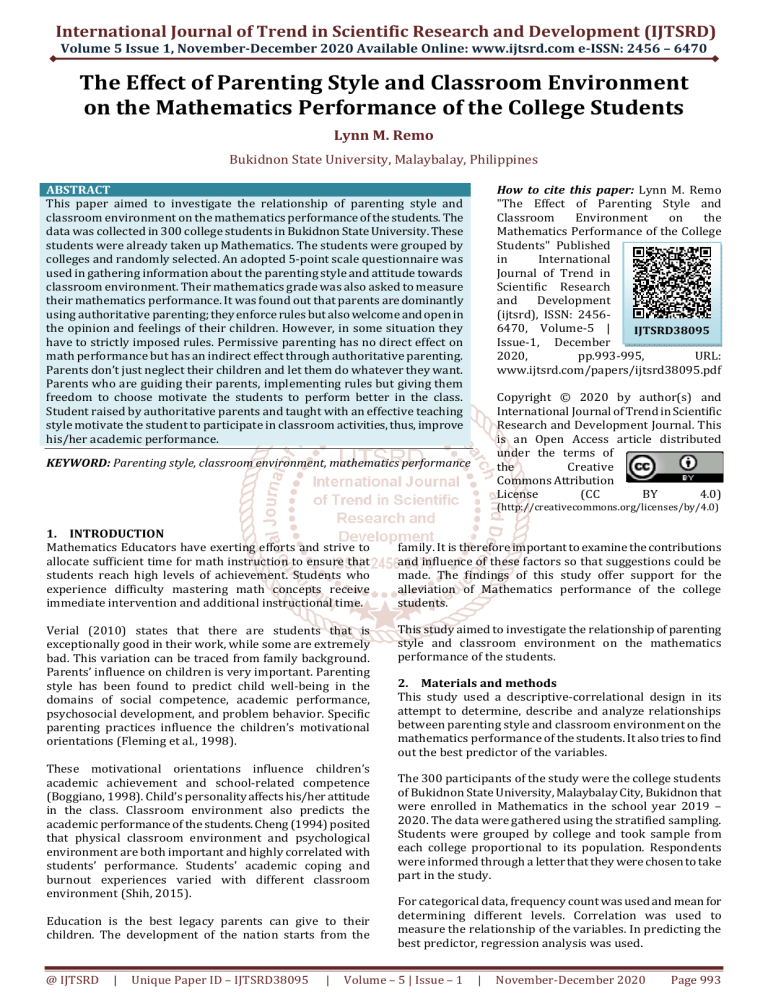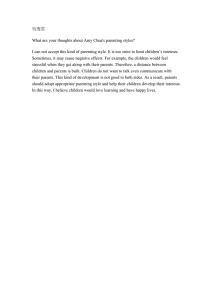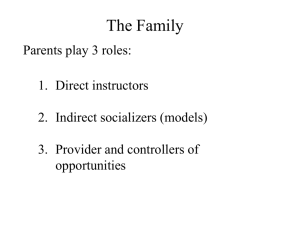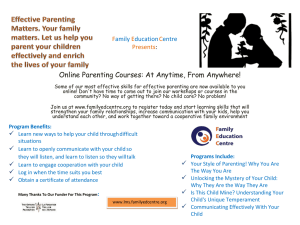
International Journal of Trend in Scientific Research and Development (IJTSRD)
Volume 5 Issue 1, November-December 2020 Available Online: www.ijtsrd.com e-ISSN: 2456 – 6470
The Effect of Parenting Style and Classroom Environment
on the Mathematics Performance of the College Students
Lynn M. Remo
Bukidnon State University, Malaybalay, Philippines
ABSTRACT
This paper aimed to investigate the relationship of parenting style and
classroom environment on the mathematics performance of the students. The
data was collected in 300 college students in Bukidnon State University. These
students were already taken up Mathematics. The students were grouped by
colleges and randomly selected. An adopted 5-point scale questionnaire was
used in gathering information about the parenting style and attitude towards
classroom environment. Their mathematics grade was also asked to measure
their mathematics performance. It was found out that parents are dominantly
using authoritative parenting; they enforce rules but also welcome and open in
the opinion and feelings of their children. However, in some situation they
have to strictly imposed rules. Permissive parenting has no direct effect on
math performance but has an indirect effect through authoritative parenting.
Parents don’t just neglect their children and let them do whatever they want.
Parents who are guiding their parents, implementing rules but giving them
freedom to choose motivate the students to perform better in the class.
Student raised by authoritative parents and taught with an effective teaching
style motivate the student to participate in classroom activities, thus, improve
his/her academic performance.
How to cite this paper: Lynn M. Remo
"The Effect of Parenting Style and
Classroom
Environment
on
the
Mathematics Performance of the College
Students" Published
in
International
Journal of Trend in
Scientific Research
and
Development
(ijtsrd), ISSN: 24566470, Volume-5 |
IJTSRD38095
Issue-1, December
2020,
pp.993-995,
URL:
www.ijtsrd.com/papers/ijtsrd38095.pdf
Copyright © 2020 by author(s) and
International Journal of Trend in Scientific
Research and Development Journal. This
is an Open Access article distributed
under the terms of
the
Creative
Commons Attribution
License
(CC
BY
4.0)
KEYWORD: Parenting style, classroom environment, mathematics performance
(http://creativecommons.org/licenses/by/4.0)
1. INTRODUCTION
Mathematics Educators have exerting efforts and strive to
allocate sufficient time for math instruction to ensure that
students reach high levels of achievement. Students who
experience difficulty mastering math concepts receive
immediate intervention and additional instructional time.
Verial (2010) states that there are students that is
exceptionally good in their work, while some are extremely
bad. This variation can be traced from family background.
Parents’ influence on children is very important. Parenting
style has been found to predict child well-being in the
domains of social competence, academic performance,
psychosocial development, and problem behavior. Specific
parenting practices influence the children’s motivational
orientations (Fleming et al., 1998).
These motivational orientations influence children’s
academic achievement and school-related competence
(Boggiano, 1998). Child’s personality affects his/her attitude
in the class. Classroom environment also predicts the
academic performance of the students. Cheng (1994) posited
that physical classroom environment and psychological
environment are both important and highly correlated with
students’ performance. Students' academic coping and
burnout experiences varied with different classroom
environment (Shih, 2015).
Education is the best legacy parents can give to their
children. The development of the nation starts from the
@ IJTSRD
|
Unique Paper ID – IJTSRD38095
|
family. It is therefore important to examine the contributions
and influence of these factors so that suggestions could be
made. The findings of this study offer support for the
alleviation of Mathematics performance of the college
students.
This study aimed to investigate the relationship of parenting
style and classroom environment on the mathematics
performance of the students.
2. Materials and methods
This study used a descriptive-correlational design in its
attempt to determine, describe and analyze relationships
between parenting style and classroom environment on the
mathematics performance of the students. It also tries to find
out the best predictor of the variables.
The 300 participants of the study were the college students
of Bukidnon State University, Malaybalay City, Bukidnon that
were enrolled in Mathematics in the school year 2019 –
2020. The data were gathered using the stratified sampling.
Students were grouped by college and took sample from
each college proportional to its population. Respondents
were informed through a letter that they were chosen to take
part in the study.
For categorical data, frequency count was used and mean for
determining different levels. Correlation was used to
measure the relationship of the variables. In predicting the
best predictor, regression analysis was used.
Volume – 5 | Issue – 1
|
November-December 2020
Page 993
International Journal of Trend in Scientific Research and Development (IJTSRD) @ www.ijtsrd.com eISSN: 2456-6470
3. Results & Discussion
It can be shown in table 1 that most of the parents rarely
used permissive parenting. Sometimes they tend to apply
authoritarian way. But dominantly, parents tend to utilize
authoritative parenting.
Table 1 Distribution of students according to
parenting style
Mean Description
Authoritative 3.70
Often
Authoritarian 2.73
Sometimes
Permissive
2.23
Rarely
Parents are more responsive to the feelings and needs of
their children. They always respect their children’s opinion
and rarely yell them or spank them when they disapprove
their children’s behavior. Parents still enforce rules to their
children but also listen to their opinion and feelings. The
impact of academic self-concept on academic achievement is
found to be greater for the authoritative than the
authoritarian parenting style (Ishak et al., 2012).
Table 2 Distribution of students according to
classroom environment
Mean Description
Physical environment
3.86
Agree
Social environment
4.13
Agree
Academic environment 3.91
Agree
The respondents agreed that a favorable classroom
environment can motivate and improve the mathematics
performance of the students. Ikeda (2010) asserts that
orderly classrooms – regardless of the school’s overall socioeconomic profile are related to better performance.
Guardino et al. (2010) posited that classroom environment
can increase academic engagement and decrease disruptive
behavior of the students.
Family income has significant positive relationship with the
social and academic environment which can be shown in
table 3. It implies that socio-economically disadvantaged
students are less likely to participate in classroom activities.
Those students also have less expectation and understanding
of the task given to them by their teacher.
Physical environment has a significant positive relationship
with social and academic environment. It means that the
physical appearance of the classroom and using of
technology in instruction can motivate the students to
participate in class and can also develop positive response to
their teachers. Social environment can have a significant
positive relationship with authoritative parenting style.
Students brought up by parents who are open-minded and
imposing discipline in a caring atmosphere, have a higher
expectation on their teachers’ effectiveness.
It can be seen in table 4, that a more favorable classroom
environment can have an increase in the mathematics
performance. Family income and age of the students have
the same effect with the performance of the students. The
higher the income of the family, the better is the
performance of the students. However, these effects are not
significant (p-value>0.05).
@ IJTSRD
|
Unique Paper ID – IJTSRD38095
|
The equation suggests that the inherent grade of the
respondent is 3.50. In every one unit of permissive
parenting, 0.115 increase in the math grade of the student.
One unit increase of authoritarian parenting can have a
decrease of 0.197 in the math grade of the students. One unit
increase in authoritative parenting can have 0.114 increases
in the grade of the student. One unit increase in the
Academic environment can have a decrease of 0.01 in the
grade of the student. One unit increase in social environment
can have an increase of 0.09 math grade of the student and
one unit increase in physical environment can have a
decrease of 0.20 math grade of the student.
Table 3 Relationship of classroom environment,
family income, parenting style and mathematics
performance
Correlation
p-value
coefficient
GRADE
Classroom Environment
Physical
-.108
.285
Social
.058
.568
Academic
.045
.658
parenting style
Authoritative .153
.128
Authoritarian -.159
.114
Permissive
-.039
.703
Income
.140
.166
INCOME Classroom Environment
Physical
.164
.104
Social
.233*
.019
Academic
.225*
.024
parenting style
Authoritative .132
.190
Authoritarian -.078
.439
Permissive
-.044
.662
Physical Social
.553**
.000
Academic
.498**
.000
Authoritative .125
.214
Authoritarian .130
.198
Permissive
.141
.161
Social
Academic
.575**
.000
Authoritative .327**
.001
Authoritarian .022
.825
Permissive
.084
.404
The equation (1) suggests that in every one unit of
permissive parenting, an increase in the math grade of the
student. One unit increase of authoritarian parenting can
have a decrease of 0.197 in the math grade of the students.
One unit increase in authoritative parenting can have 0.114
increases in the grade of the student. One unit increase in the
Academic environment can have a decrease of 0.01 in the
grade of the student. One unit increase in social environment
can have an increase of 0.09 math grade of the student and
one unit increase in physical environment can have a
decrease of 0.20 math grade of the student.
Performance = 3.5 + 0.115Permissive–0.197Authoritarian
+ 0.114Authoritative – 0.01Academic + 0.09Social – 0.20
Physical
(1)
Volume – 5 | Issue – 1
|
November-December 2020
Page 994
International Journal of Trend in Scientific Research and Development (IJTSRD) @ www.ijtsrd.com eISSN: 2456-6470
1
Model
(Constant)
Permissive
Authoritarian
Authoritative
Academic
Social
Physical
Table 4 Coefficients
Unstandardized Coefficients Standardized Coefficients
B
Std. Error
Beta
3.502
.739
.115
.103
.164
-.197
.113
-.260
.114
.085
.156
-.010
.131
-.011
.090
.138
.089
-.200
.142
-.182
t
4.741
1.116
-1.744
1.339
-.080
.654
-1.412
Sig.
.000
.267
.085
.184
.937
.515
.161
However, the significant values suggest that there is no significant predictor between classroom environment and parenting
style on the mathematics performance of the students.
4. Conclusions
Students believe that a well-ordered classroom, an effective
and fair teacher and an active participation in the class
activities can be the factors that improve their mathematics
performance. The physical appearance of the classroom and
using of technology in instruction can motivate the students
to participate in class and can also develop positive response
to their teachers.
Social environment can have a significant positive
relationship with authoritative parenting style. Students
brought up by parents who are open-minded and imposing
discipline in a caring atmosphere, have a higher expectation
on their teachers’ effectiveness.
[7]
[8]
[9]
5. Acknowledgments
This paper would not have been possible without the
guidance and the help of my colleagues, Bukidnon State
University and my family who in one way or another
contributed and extended their valuable assistance in the
preparation and completion of this study.
6. References
[1] Barth, J. M., Dunlap, S. T., Dane, H., Lochman, J. E., &
Wells, K. C. (2004). Classroom environment influences
on aggression, peer relations, and academic focus.
Journal of School Psychology, 42(2), 115–133.
http://doi.org/10.1016/j.jsp.2003.11.004
[2] Brock, L. L., Nishida, T. K., Chiong, C., Grimm, K. J., &
Rimm-Kaufman, S. E. (2008). Children’s perceptions
of the classroom environment and social and
academic performance: A longitudinal analysis of the
contribution of the Responsive Classroom approach.
Journal of School Psychology, 46(2), 129–149.
http://doi.org/10.1016/j.jsp.2007.02.004
[3] Donnelly, J. E., & Lambourne, K. (2011). Classroombased physical activity, cognition, and academic
achievement. Preventive Medicine, 52(SUPPL.).
http://doi.org/10.1016/j.ypmed.2011.01.021
[4] Dorman, J. P. (2001). Associations Between Classroom
Environment and Academic Efficacy. Learning
Environments
Research,
4(3),
243–257.
http://doi.org/10.1023/A:1014490922622
[5] Dornbusch, S. M., Ritter, P. L., Leiderman, P. H.,
Roberts, D. F., & Fraleigh, M. J. (1987). The relation of
parenting style to adolescent school performance.
Child
Development,
58(5),
1244–1257.
http://doi.org/10.2307/1130618
[6] Fast, L. a., Lewis, J. L., Bryant, M. J., Bocian, K. a.,
Cardullo, R. a., Rettig, M., & Hammond, K. a. (2010).
Does math self-efficacy mediate the effect of the
@ IJTSRD
|
Unique Paper ID – IJTSRD38095
|
[10]
[11]
[12]
[13]
[14]
[15]
perceived classroom environment on standardized
math test performance? Journal of Educational
Psychology,
102(3),
729–740.
http://doi.org/10.1037/a0018863
Flook, L., Repetti, R. L., & Ullman, J. B. (2005).
Classroom social experiences as predictors of
academic performance. Developmental Psychology,
41(2), 319–327. http://doi.org/10.1037/00121649.41.2.319
Gettinger, M., Schienebeck, C. J., Seigel, S., & Vollmer, L.
(2012). Assessment of Classroom Environments. In
The Oxford Handbook of School Psychology.
http://doi.org/10.1093/oxfordhb/9780195369809.0
13.0099
Gherasim, L. R., Butnaru, S., & Mairean, C. (2013).
Classroom environment, achievement goals and
maths performance: gender differences. Educational
Studies,
39(1),
1–12.
http://doi.org/10.1080/03055698.2012.663480
Guardino, C. a, & Fullerton, E. (2010). Changing
Behaviors by Changing the Classroom Environment.
Teaching Exceptional Children, 42(6), 8–13.
http://doi.org/10.1177/004005991004200601
Ishak, Z., Low, S. F., & Lau, P. L. (2012). Parenting Style
as a Moderator for Students’ Academic Achievement.
Journal of Science Education and Technology, 21(4),
487– 493. http://doi.org/10.1007/s10956-011-93401
Nyarko, K. (2011). The influence of authoritative
parenting style on adolescents’ academic
achievement. American Journal of Social and
Management
Sciences,
2(3),
278–282.
http://doi.org/10.5251/ajsms.2011.2.3.278.282
Suleman, Q., & Hussain, D. I. (2014). Effects of
Classroom Physical Environment on the Academic
Achievement Scores of Secondary School Students in
Kohat Division, Pakistan. International Journal of
Learning
and
Development.
http://doi.org/10.5296/ijld.v4i1.5174
Taylor, L. C., Hinton, I. D., & Wilson, M. N. (1995).
Parental influences on academic performance in
African-American students. Journal of Child and
Family
Studies,
4(3),
293–302.
http://doi.org/10.1007/BF02233964
Turner, E. a., Chandler, M., & Heffer, R. W. (2009). The
Influence of Parenting Styles, Achievement
Motivation, and Self-Efficacy on Academic
Performance in College Students. Journal of College
Student
Development,
50(3),
337–346.
http://doi.org/10.1353/csd.0.0073
Volume – 5 | Issue – 1
|
November-December 2020
Page 995



